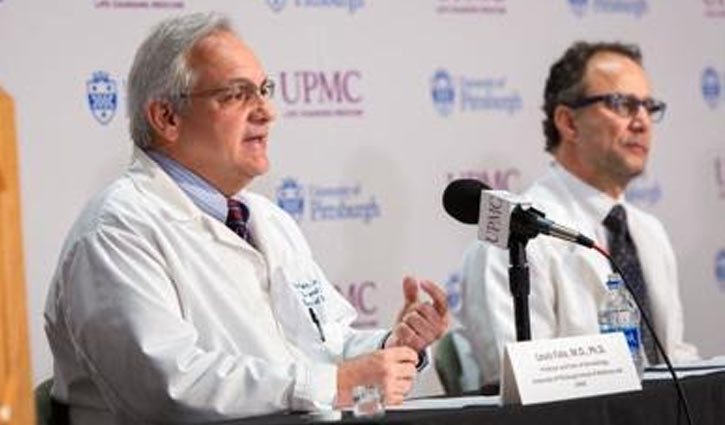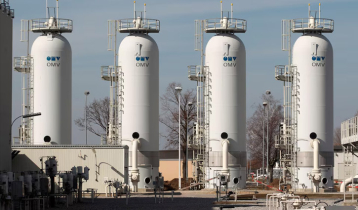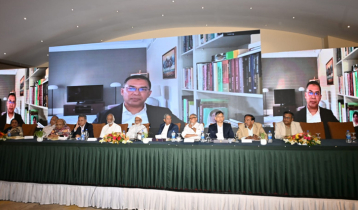Pittsburgh University researchers invent coronavirus vaccine!
8 || risingbd.com

A potential vaccine for COVID-19 has been developed and tested successfully in mice, researchers reported Thursday.
"We'd like to get this into patients as soon as possible," said Andrea Gambotto, associate professor of surgery at the University of Pittsburgh School of Medicine and co-author of a paper announcing the vaccine in the journal EBioMedicine.
As far as reaching clinical trials, "we would like to think a month, give or take. Maybe two months. We just started the process," said co-author Louis Falo, a professor and chairman of the Department of Dermatology at the University of Pittsburgh.
Thursday's announcement, more than three months into a pandemic that has killed 50,000 people and sickened almost 1 million worldwide, presents an urgent challenge to government regulators, who must weigh how much to speed up the vaccine approval process.
Vaccines often take years to receive approval from the U.S. Food and Drug Administration. Yet on March 16, the first four healthy volunteers in Seattle received a different potential COVID-19 vaccine, made by a company called Moderna and administered in a small clinical trial at Kaiser Permanente Washington Health Research Institute.
Though the vaccine being tested in Seattle uses a new, faster but untested technology, the one developed in Pittsburgh employs the same technique used in flu shots. The Pittsburgh vaccine uses lab-made viral protein to build a person's immunity to the virus.
Tests in mice found that the vaccine spurred a wave of virus-fighting antibodies within two weeks.
"There are many, many vaccine candidates in various stages of testing," said David O'Connor, professor at the University of Wisconsin School of Medicine and Public Health, who saw the published paper for the first time Thursday.
O'Connor said showing that a vaccine generates an immune response is "an important first step in determining which vaccines should move forward, but is only the first of many steps along the way to a useful vaccine. This paper shows some of this 'first step' data."
The potential COVID-19 vaccine follows up on research Gambotto and Falo did in December 2003 when they were poised to proceed to clinical trials with a vaccine for another coronavirus, Severe Acute Respiratory Syndrome. At the time, the journal Nature reported, "SARS vaccines speed toward clinic."
But the outbreak had already waned. The World Health Organization declared SARS contained in July 2003.
"SARS CoV-2 is teaching us that it is important to react and (follow) all the way through," Gambotto said. "Yes, it was a mistake not to test the vaccine back then."
Some scientists suggested that a vaccine for one coronavirus would probably have offered at least some protection from all of them.
The Pittsburgh researchers developed a vaccine to treat Arabian camels for another coronavirus, Middle East Respiratory Syndrome (MERS). Like SARS and COVID-19, MERS jumped from animals to people, infecting almost 2,500 and killing almost 860 since its discovery in 2012.
Gambotto said they adapted techniques they had developed for previous coronaviruses to create one specifically designed for the virus that causes COVID-19; the process of translating their work for use on COVID-19 took the scientists 10 to 12 days. They collaborated with 11 other scientists, including two from Erasmus Medical Center in Rotterdam, the Netherlands.
Gambotto and Falo said their vaccine would be delivered to the upper arm but would not require a shot from a needle as the flu vaccine does.
The scientists developed a fingertip-sized patch that contains 400 tiny needles, each just half a millimeter. The two scientists compared the patch to a Band-Aid and said it would feel a lot like having Velcro pressed against the skin.
The needles, made from sugar and protein pieces, would penetrate the upper level of skin, absorb moisture from the skin and release molecules. The molecules would prompt the immune system to make antibodies that attack the virus.
The Pittsburgh researchers touted two advantages to the vaccine they call PittCoVacc.
The vaccine does not have to be frozen when stored or transported; it can sit at room temperature. That would make the vaccine much cheaper to deliver to poorer countries.
Though the researchers could not say exactly how much a dose of the vaccine would cost, they estimated that the patch of needles used to deliver the vaccine would probably cost less than $10 a patch.
The technique employing the tiny needles releases a highly concentrated, much smaller amount of viral protein. The scientists said a single person would be able to make hundreds of vaccine patches a day.
The vaccine was developed without using the live virus that causes COVID-19. Scientists used DNA molecules made in the lab.
When released from the patch, the vaccine exploits the crucial part of the virus that latches onto human cells, the Spike protein.
The virus' Spike protein usually acts like a key opening up human cells and allowing the virus to invade. The vaccine acts a little like gum in a lock, preventing the key from working and keeping the virus from entering human cells.
Source: Agencies
Dhaka/Mukul
risingbd.com



































